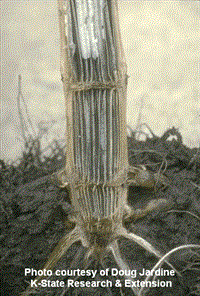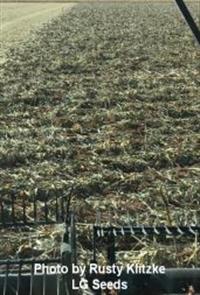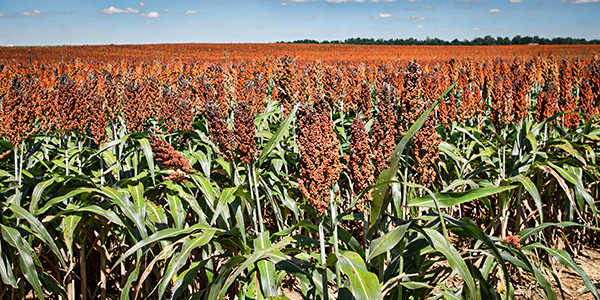AGRONOMICSUPPORT
YOU CAN TAKETO THE FIELD
Charcoal Rot in Grain Sorghum
A large issue when growing grain sorghum as a crop is stalk and root diseases. The lodging and harvest issues that can occur can be very frustrating for growers. Over the last couple of years many of the grain sorghum acres in Kansas and Nebraska have experienced issues with lodged or down sorghum. Most issues have been weather related, but some have also been affected by a common stalk rot known as charcoal rot.
Charcoal rot is caused by the fungus Macrophomi naphaseolina and effects most grain crops grown in the high plains including corn and soybeans. The disease, which is sometimes also referred to as dry-weather wilt, is usually seen when environmental conditions are exactly that, extremely hot and dry.
The fungus thrives in areas where conditions are normally hot and dry for extended periods of time. Survival of the fungus can extend for years in hot dry conditions but only a few weeks in saturated soils.


Most of the grain sorghum acres fit the geography of the exact environment that the fugus thrives in, especially those acres in the middle and southern High Plains. The disease normally starts to affect the crop when grain sorghum experiences drought and heat stress during the pre-flowering period. Many hybrids are pretty good at fighting off the disease in most cases. When stress becomes too great the disease can sometimes over power the crop and cause severe damage to lower stalk and root pith. The loss of pith and lower inner stalk structure leads to lodging. The picture on the left shows the fungus causing lower stalk and root pith loss, and the picture on right shows results of that lower stalk pith loss.
There are some things to keep in mind as a grower when conditions are more prone to experience issues like this. Stress is the major contributor to most all stalk and root issues. The pathogens that cause most of these issues are prevalent in all soils. The fungus that causes charcoal rot is one of the most prevalent fungi we deal with in the High Plains. It may or may not be a variety or hybrid issue as much as it is an environmental and growing season weather issue.
Be sure when selecting grain sorghum hybrids that you are selecting those with very good drought stress, good lodging scores, and late season stay green. Grain sorghum hybrids in general are starting to get bigger in plant structure which is in turn bringing on advanced yield. We see this within our own Golden Acres Grain Sorghum portfolio. The yield advancement in the newer hybrids is very easily seen when comparing to many of the older hybrids. The other thing that also stands out is that the plant structure of most of the newer genetics is bigger plant structures. These bigger plants are basically bigger factories that in turn produce more grain. We need to remember as well that bigger factories require more inputs, or they operate inefficiently. Like in other crops the genetic yield gain we are now seeing in sorghum means that our agronomic mindset towards the crop needs to change as well. We can’t agronomically treat the crop at a nutritional and other basic inputs level that we did 10 or even 5 years ago. When conditions get stressful, we need to be sure we are not agronomically adding to the stress by shorting the crop of something. That way the crop can put its own resources towards fighting off some of these rots, especially charcoal rot.
Sources and additional Information:






Technical Team Agronomist